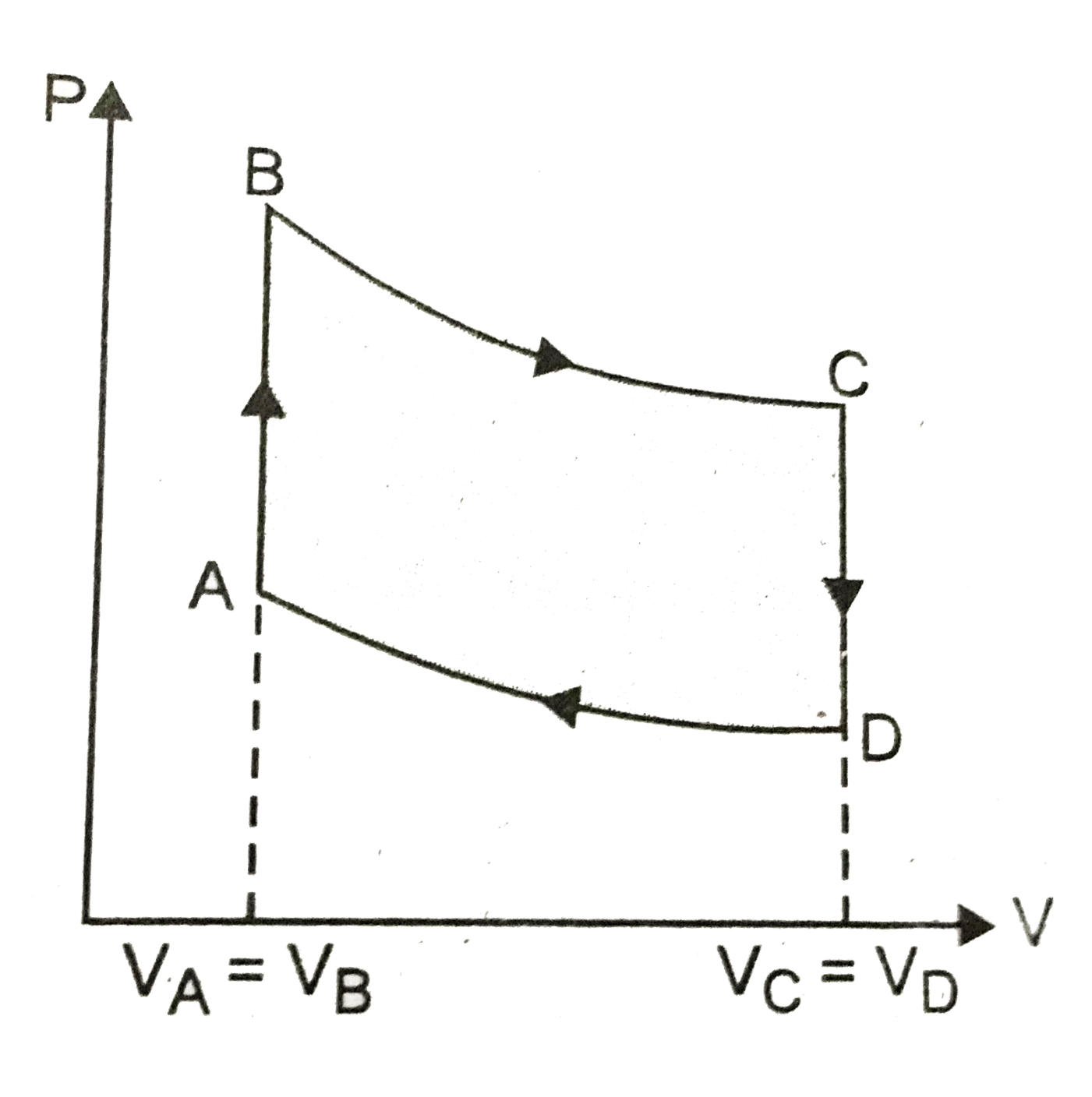A cycle followed by an engine (made of one mole of perfect gas in a cyclinder with a piston) is shown in (figure)
A to B: volume constant B to C: adiabatic
C to D: volume constant D to A: adiabatic
Vc=VD=2VA=2VB
(a) In which part of the cycle heat is supplied to the engine fron outside?
(b) In which part of the cycle heat is being given to the surrounding by the engine?
(c ) What is the work done by the engine in one cycle? Write your answer in term of PA,PB,VA.
(d) What is the efficiency of the engine? (γ=5/3for the gas), (Cv=32Rfor one mole)

As shown in (figure)
(a) Heat is supplied to the engine when the cycle of changes goes from A to B. Pressure is increasing. So does the temperature.
(b) Heat is being given to the surrounding by the engine in the part C to D. When pressure decreases aand so does the temperature.
(c ) To calculate work done by the engine in one cycle, we calculate separately work done is the four parts of cycle
WAB=∫VBVApdV=0,WCD=∫VDVCpdV=0
WBC=∫VCVBpdV=K∫VCVBdVVγ=K1−γ[V1−γ]VCVB=11−γ[PV]VCVB=(PCVC−PBVB)1−γ
Similarly, WDA=PAVA−PDVD1−γ
As B and C lie on same adiabatic curve, therefore,
PBVγB=PCVγCorPC=PB(VBVC)γ=PB(12)γ=2−γPB
Similarly, PD=2−γPA
Total work done by the engine in one cycle
W=WAB+WBC+WCD+WDA=WBC+WDA=(PCVC−PBVB)1−γ+PAVA−PDVD1−γ
W=11−γ[2−γPB(2VB)−PBVB+PAVA−2−γPA(2VA)]
W=11−γ[(21−γ−1)PBVB+(21−γ−1)PAVA]
W=(21−γ−1)1−γ(PB−PA)VA=(1−21−5/3)(5/3−1)(PB−PA)VA⟨.VB=VA)
W=32[1−(12)2/3](PB−PA)VA
(d) Efficiency, η=Net work done/cycleHeat energy supplied/cycle=WQAB....(ii)
As WAB=0,∴,QAB=UAB=32nRT(TB−TA)=32×1(PB−PA)VA
From (ii), η=3/2[1−(12)2/3](PB−PA)VA32(PB−PA)VA=[1−(12)2/3]
Topper's Solved these Questions
- THERMODYNAMICSBook:PRADEEPChapter:THERMODYNAMICSExercise:Higher order thinking skills
Explore 9 Videos
- THERMODYNAMICSBook:PRADEEPChapter:THERMODYNAMICSExercise:Value based Questions
Explore 4 Videos
- THERMODYNAMICSBook:PRADEEPChapter:THERMODYNAMICSExercise:Short answer questions(NCERT)
Explore 6 Videos
- SYSTEMS OF PARTICLES AND ROTATIONAL MOTIONBook:PRADEEPChapter:SYSTEMS OF PARTICLES AND ROTATIONAL MOTIONExercise:Assertion- Reason Type questions
Explore 20 Videos
- WORK, ENERGY AND POWERBook:PRADEEPChapter:WORK, ENERGY AND POWERExercise:Assertion-Reason Type Questions
Explore 24 Videos
Similar Questions
A cycle followed by an engine (made of one mole of perfect gas in a cylinder with a piston) is shown in figure.

A to B volume constant, B to C adiabatic, C to D volume constant and D to A adiabatic
VC=VD=2VA=2VB
(a) In which part of the cycle heat is supplied to the engine form outside?
(b) In which part of the cycle heat is being given to the surrounding by the engine ?
(c ) What is the work done by the engine in one cycle ? Write your answer in term of pA,pB,VA ?
(d) What is the efficiency of the engine ?
(γ=53 for the gas), (CV=32R for one mole )
View SolutionA cycle followed by an engine (made of one mole of an ideal gas in a cyclinder with a piston ) is shown if figure . Find heat exchanged by the enigen, with the surrodings for each section of the cycle . [CV=(3/2)R]

View Solution
Knowledge Check
A cycle followed an engine (made of one mole of an ideal gas in a cylinder with a piston) is shown in figure The heat exchanged by the engine with the surroundings at constant volume is (Take CV=32R)
 A(PB−PA)VAB12(PB−PA)VAC32(PB−PA)VAD52(PB−PA)VA
A(PB−PA)VAB12(PB−PA)VAC32(PB−PA)VAD52(PB−PA)VAThe cycle is shown in figure is made of one mole of perfect gas in a cylinder with a piston . The processes A to B and C to D are isochoric wheras process B to C and D to A are adiabatic, the work done in one cycle is (VA=VB=V,VC=VD=2Vand γ=5/3)
 A[1−432](PB−PA)VB32[1−323](PB−PA)VC32[1−2−23](PB−PA)VD52[1−2−23](PB−PA)V
A[1−432](PB−PA)VB32[1−323](PB−PA)VC32[1−2−23](PB−PA)VD52[1−2−23](PB−PA)VThe cycle in the figure followed by an engine made of an ideal gas in ca cylinder with a piston, the heat exchanged by the engine with the surroundings for adiabatic section AB of cycle is (CV=32R)
 A32(PB−PA)VAB52PA(VA−VB)C12(PA−PB)(VA−VB)DZero
A32(PB−PA)VAB52PA(VA−VB)C12(PA−PB)(VA−VB)DZero
A cycle followed by an engine (made of one mole of an ideal gas in a cyclinder with a piston) is shown in (figure). Find heat exchanged by the engine, with the surrounding for each section of the cycle. [CV=(3/2)R]
AB : constant volume BC : constant pressure
CD : adiabatic DA : constant pressure.

View SolutionA diatomic ideal gas is used in a Carnot engine as theworking substance. If during the adiabatic expansion part of the cycle the volume of the gas increases from V to 32 V, the efficiency of the engine is
View SolutionA diatomic ideal gas is used in a Carnot engine as the working substance. If during the adiabatic expansion part of the cycle the volume of the gas increases from V to 32 V, the efficiency of the engine is -
View SolutionA diatomic ideal gas is used in a Carnot engine as the working substance. If during the adiabatic expansion part of the cycle the volume of the gas increase from V to 32V, the efficenecy of the engine is
View SolutionA monoatomic ideal gas is used in a carnot engine as the working substance. If during the adiabatic expansion the volume of the gas increases from V8 to V, the efficiency of the engine is
View Solution

